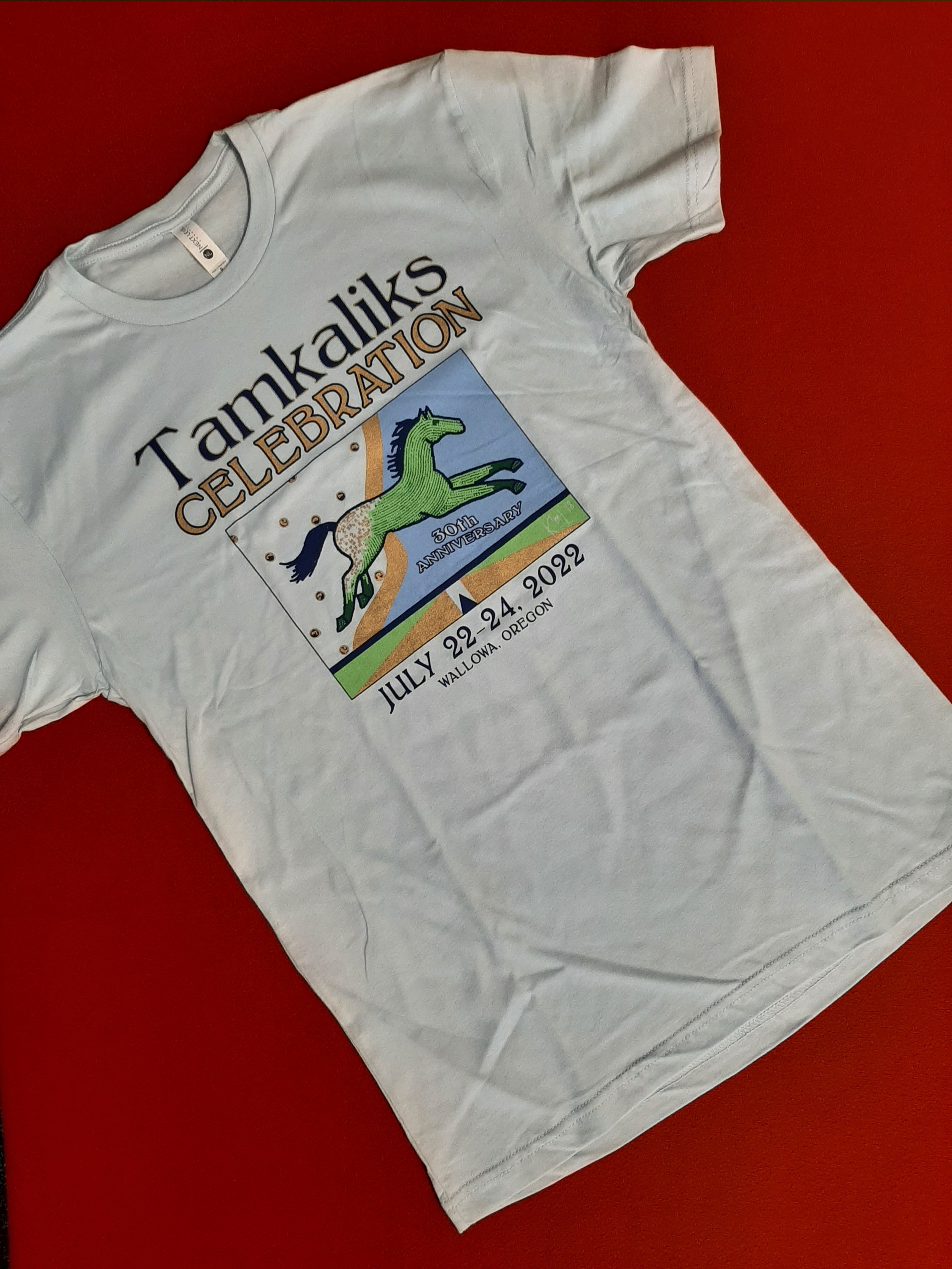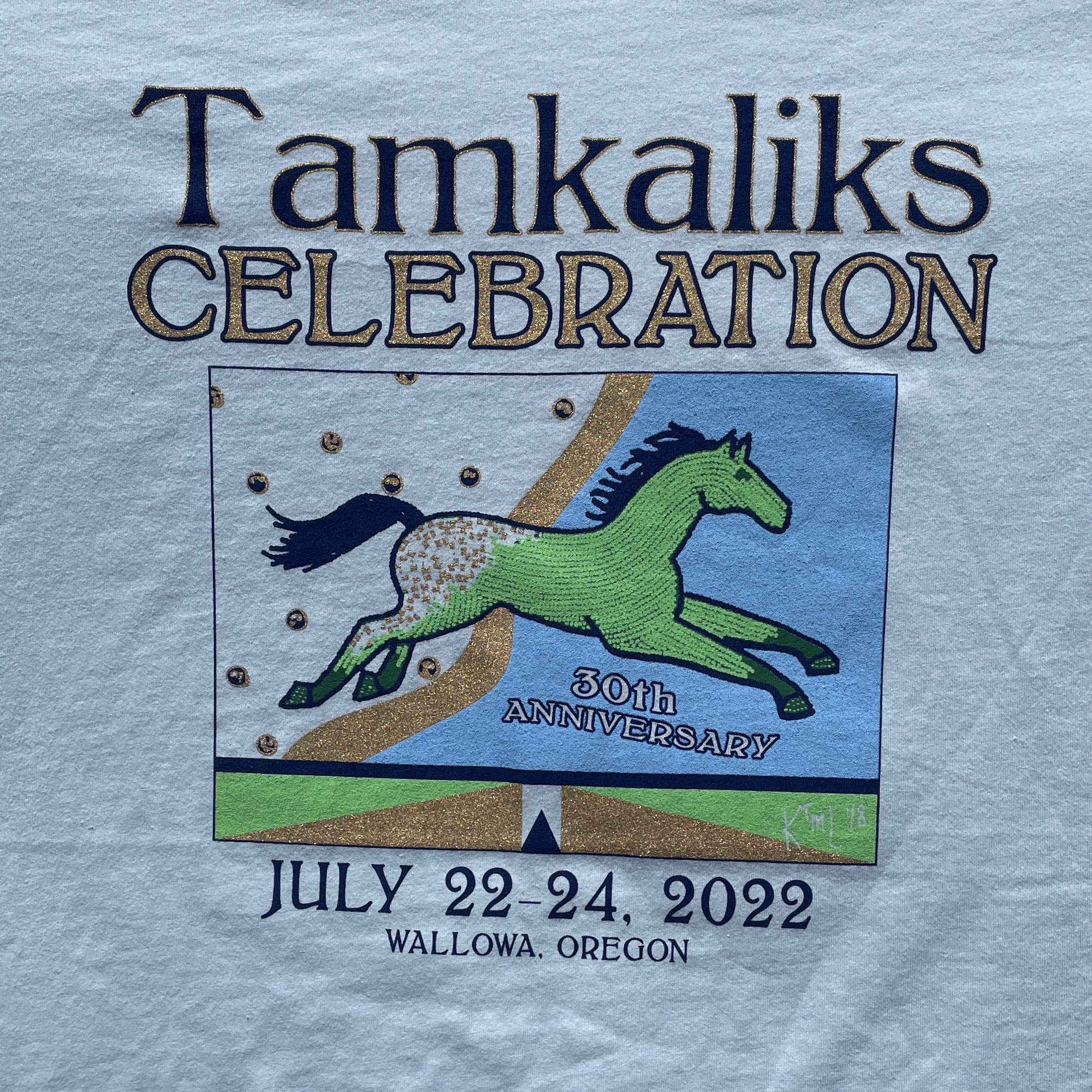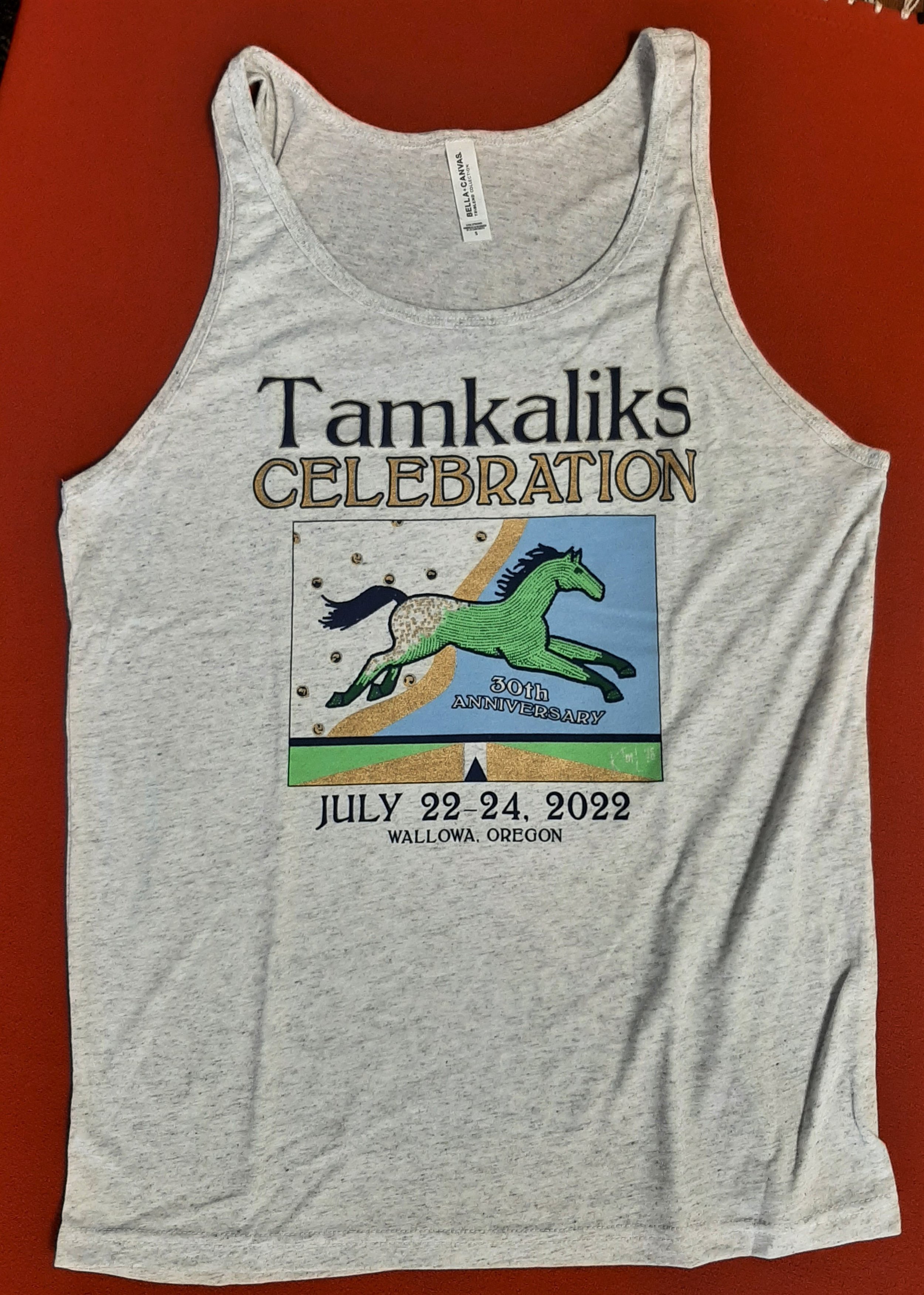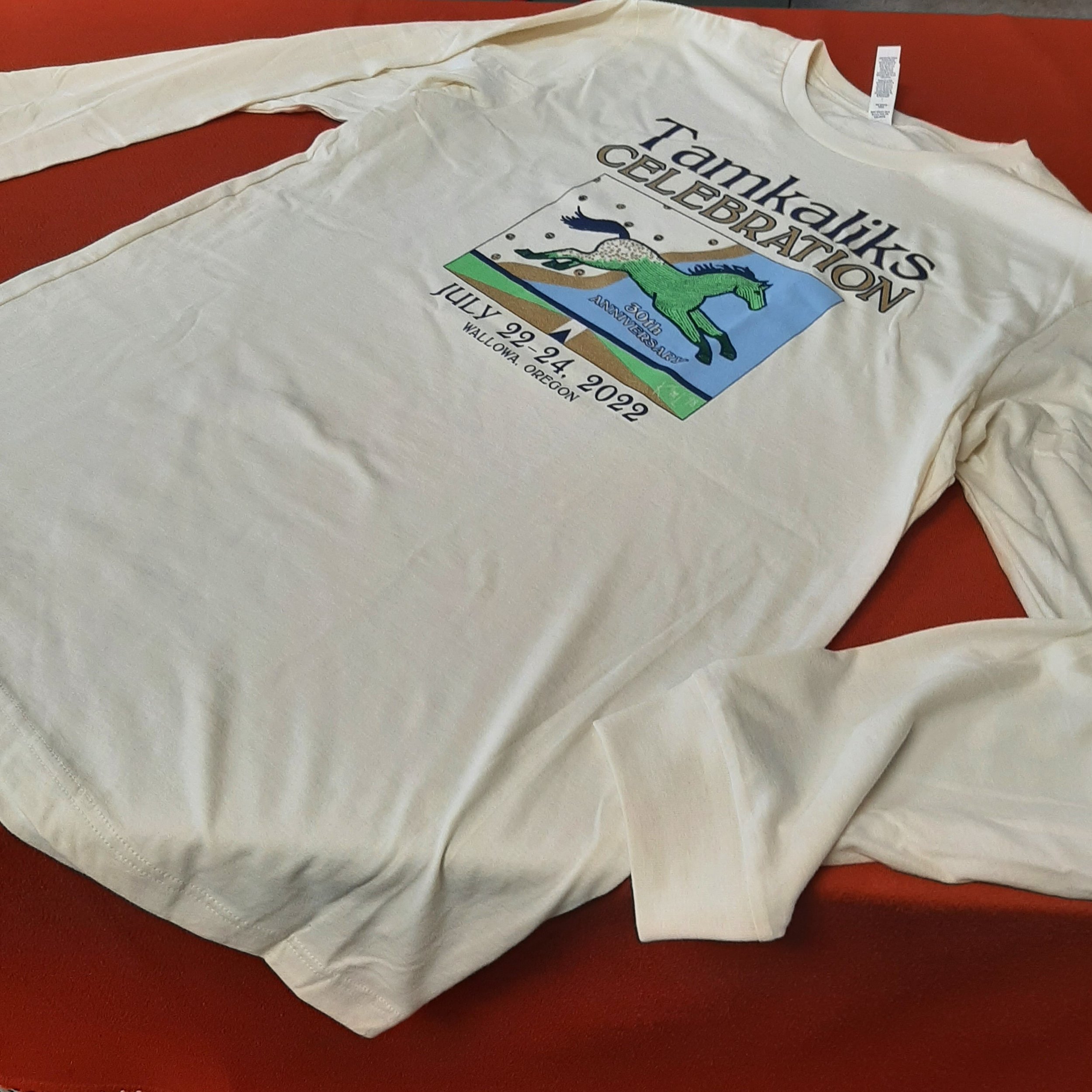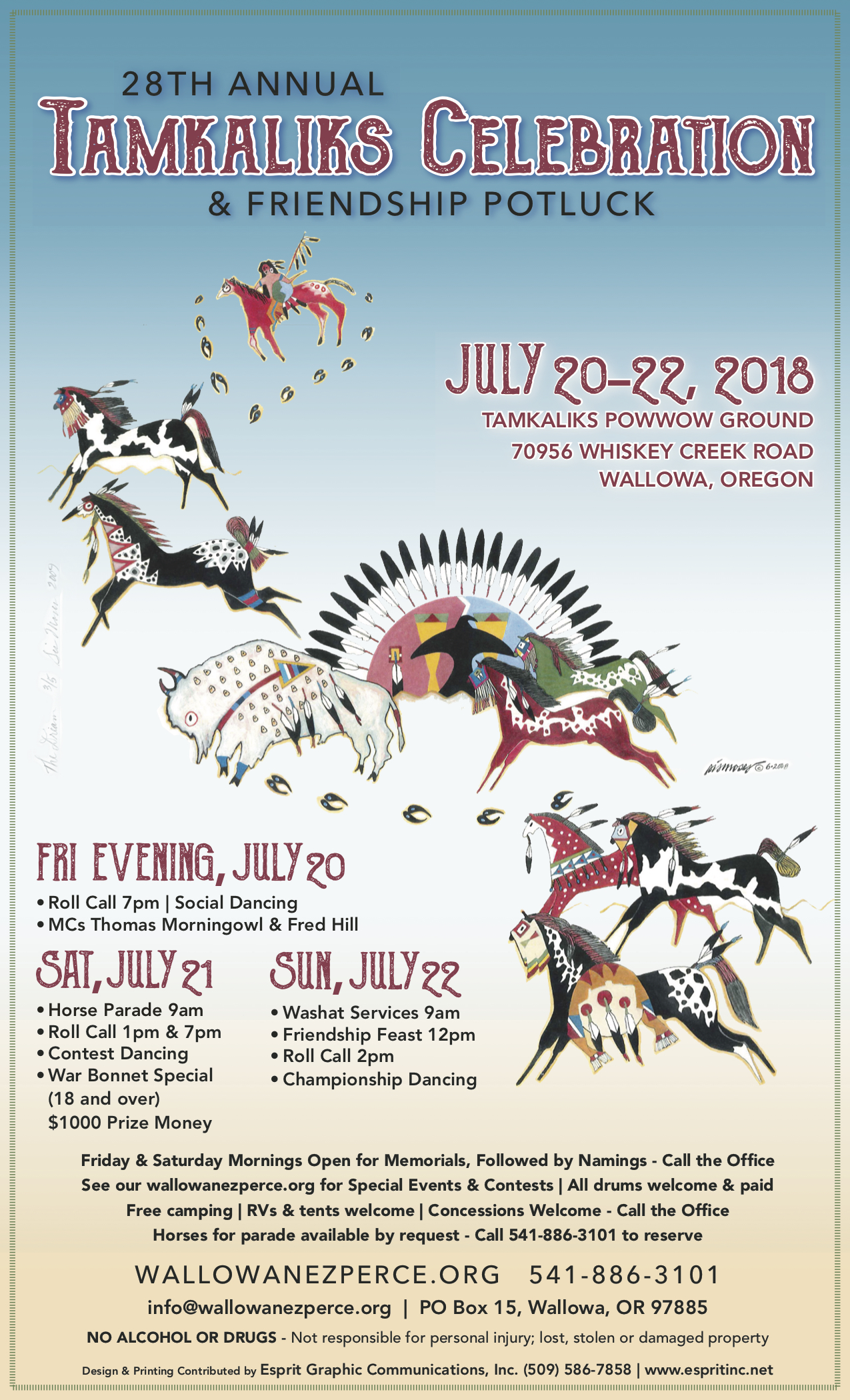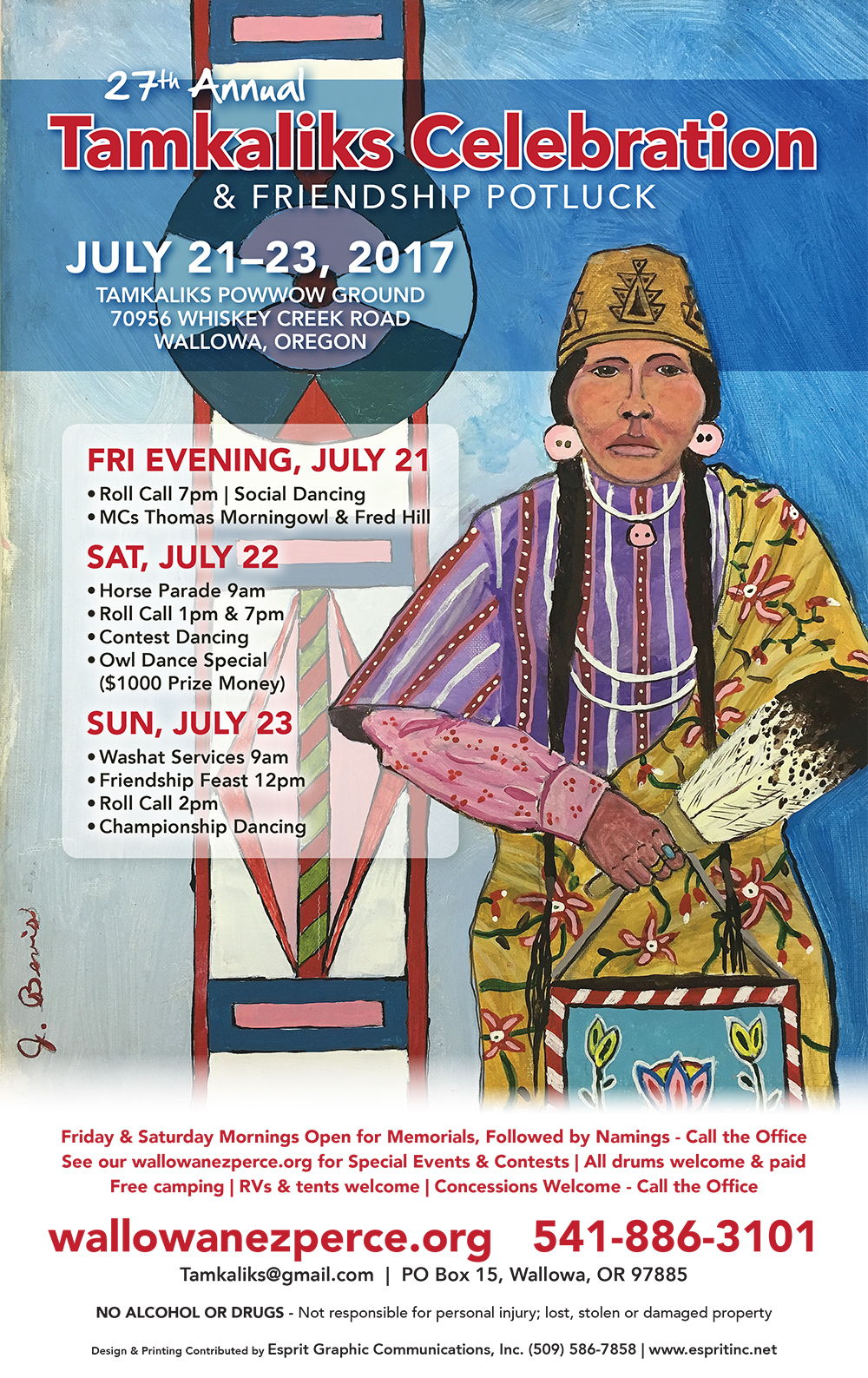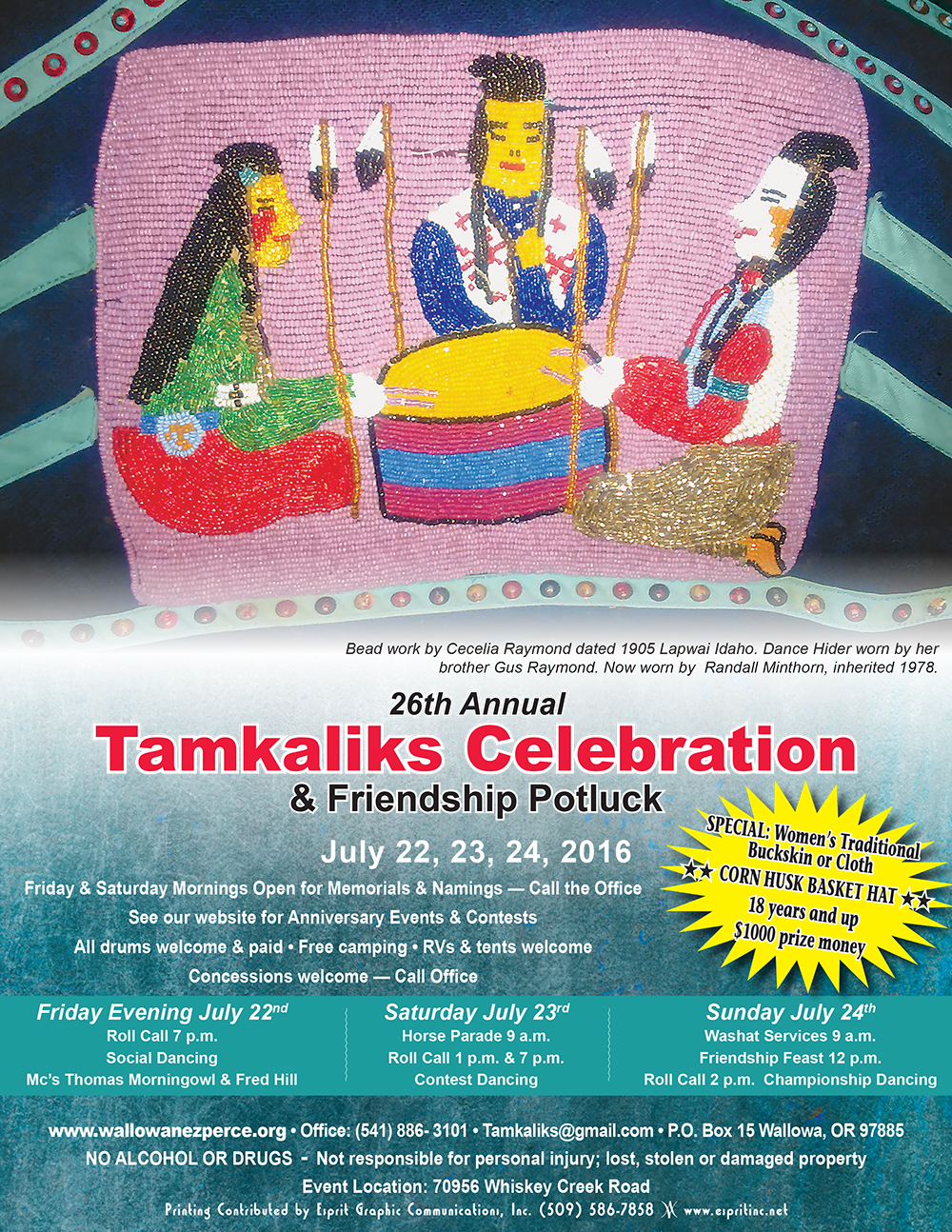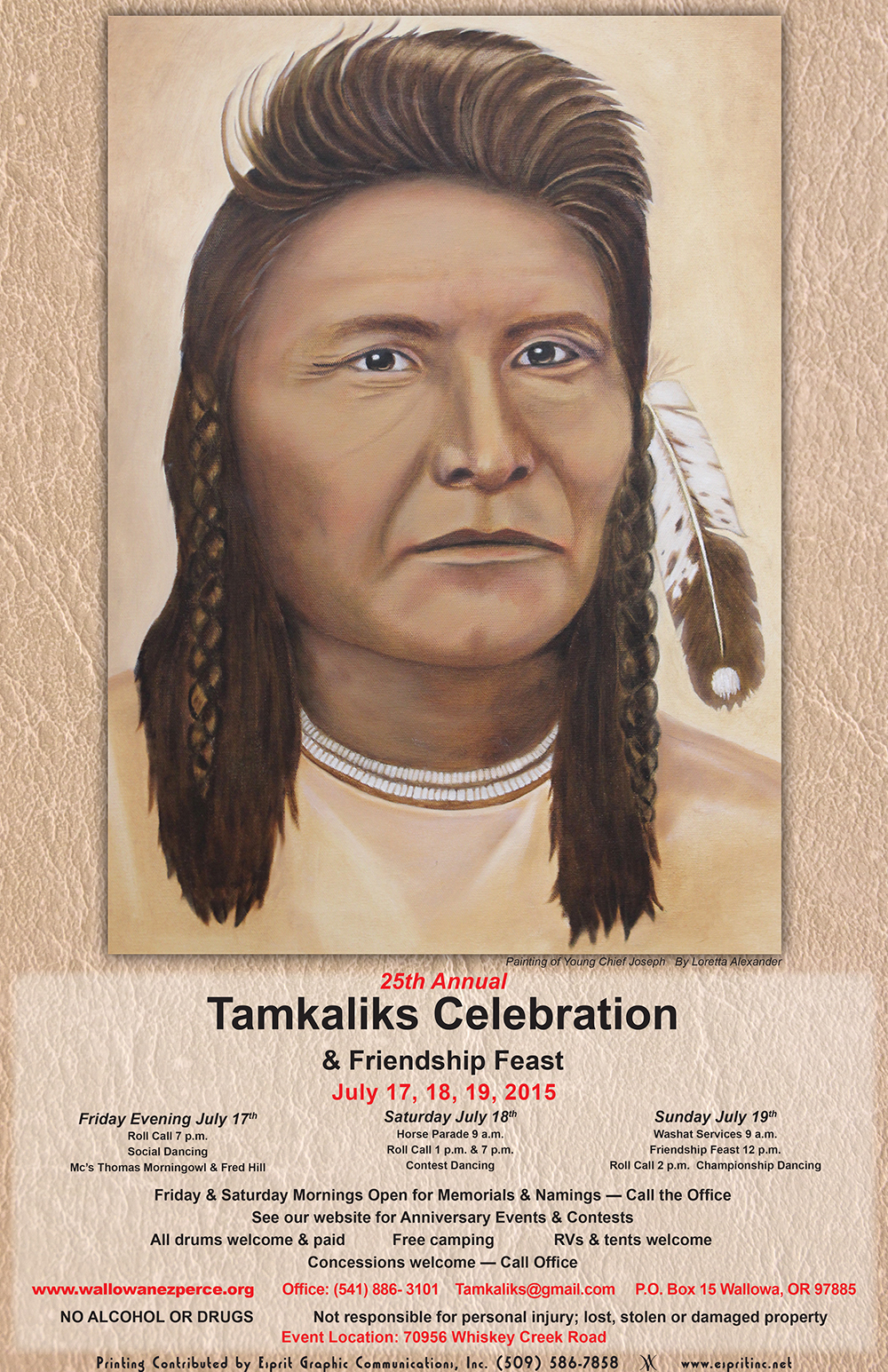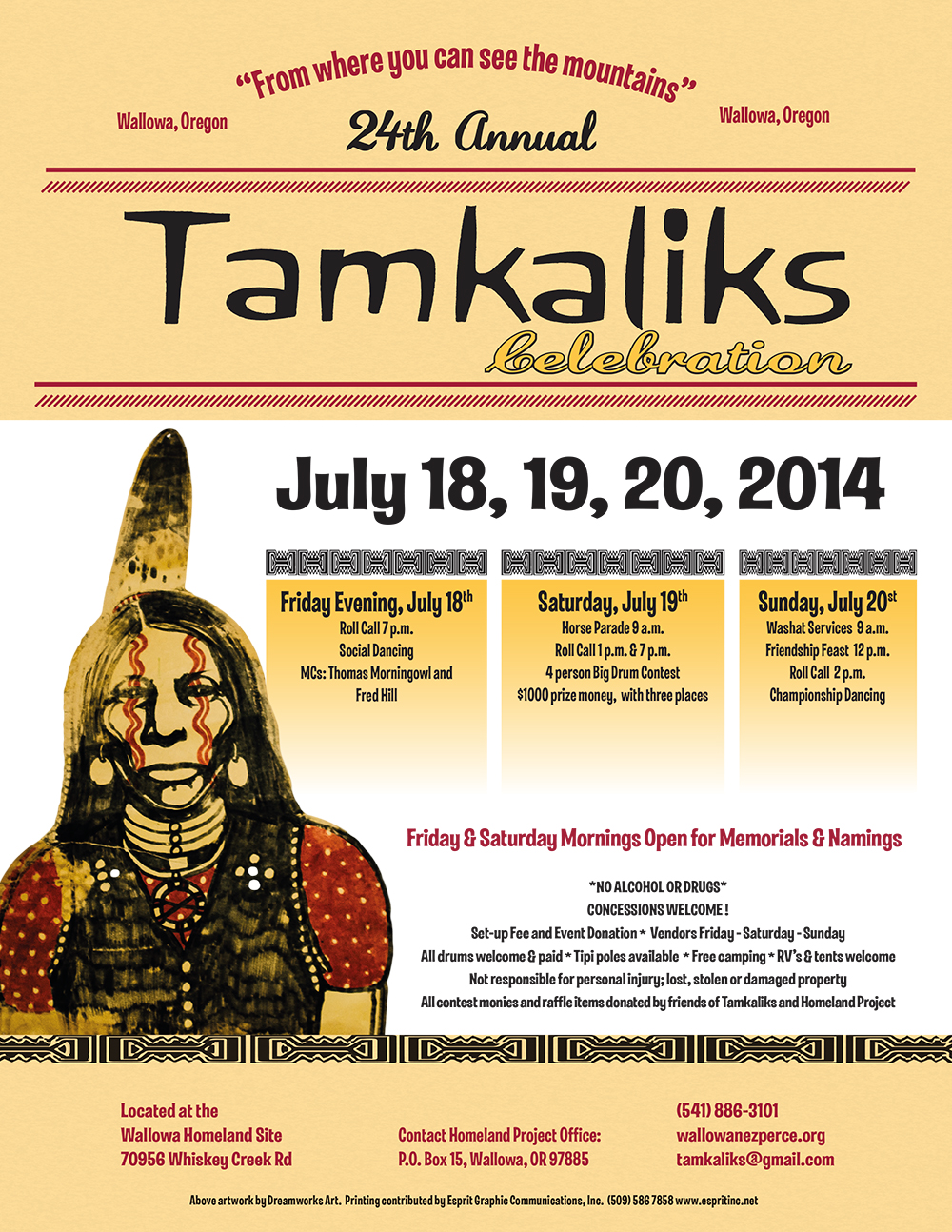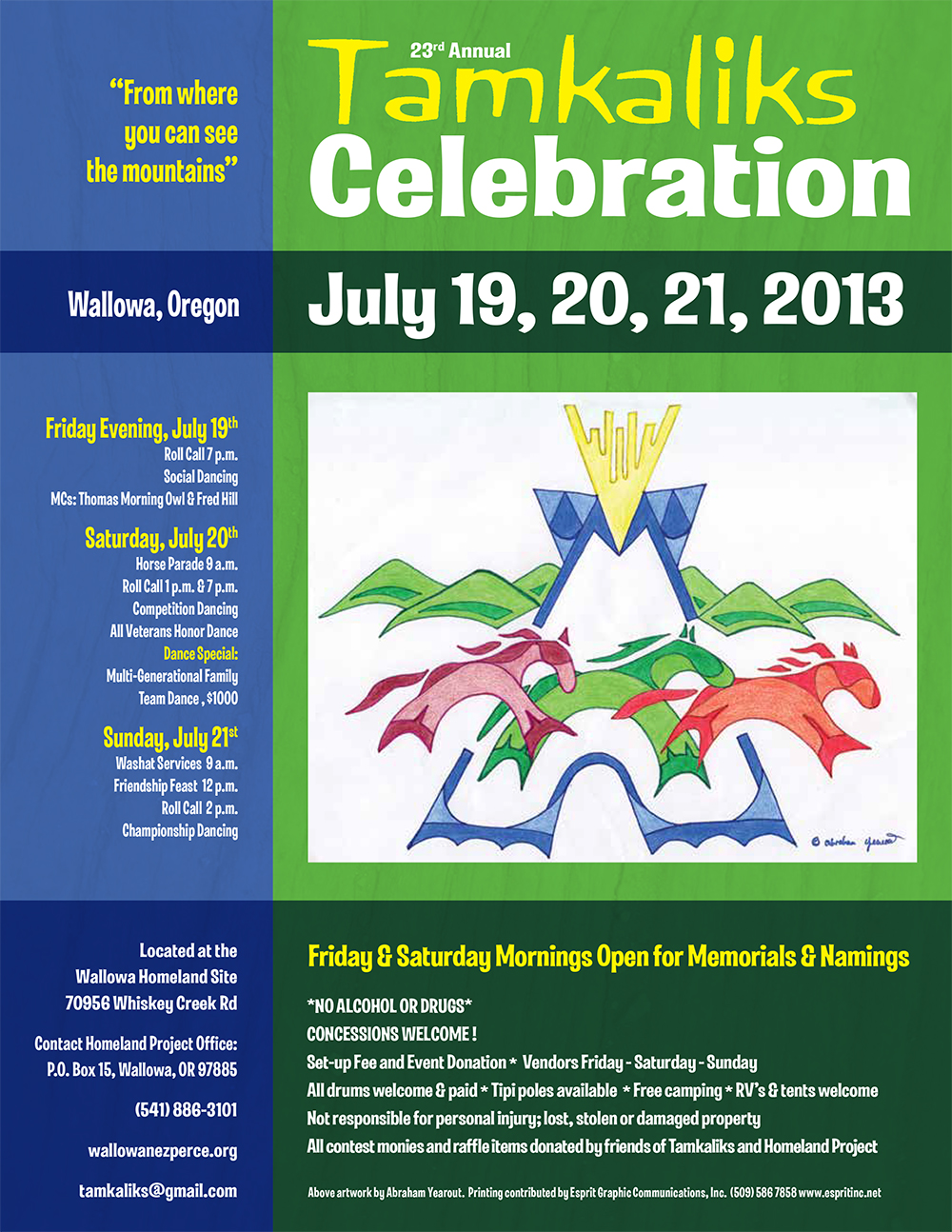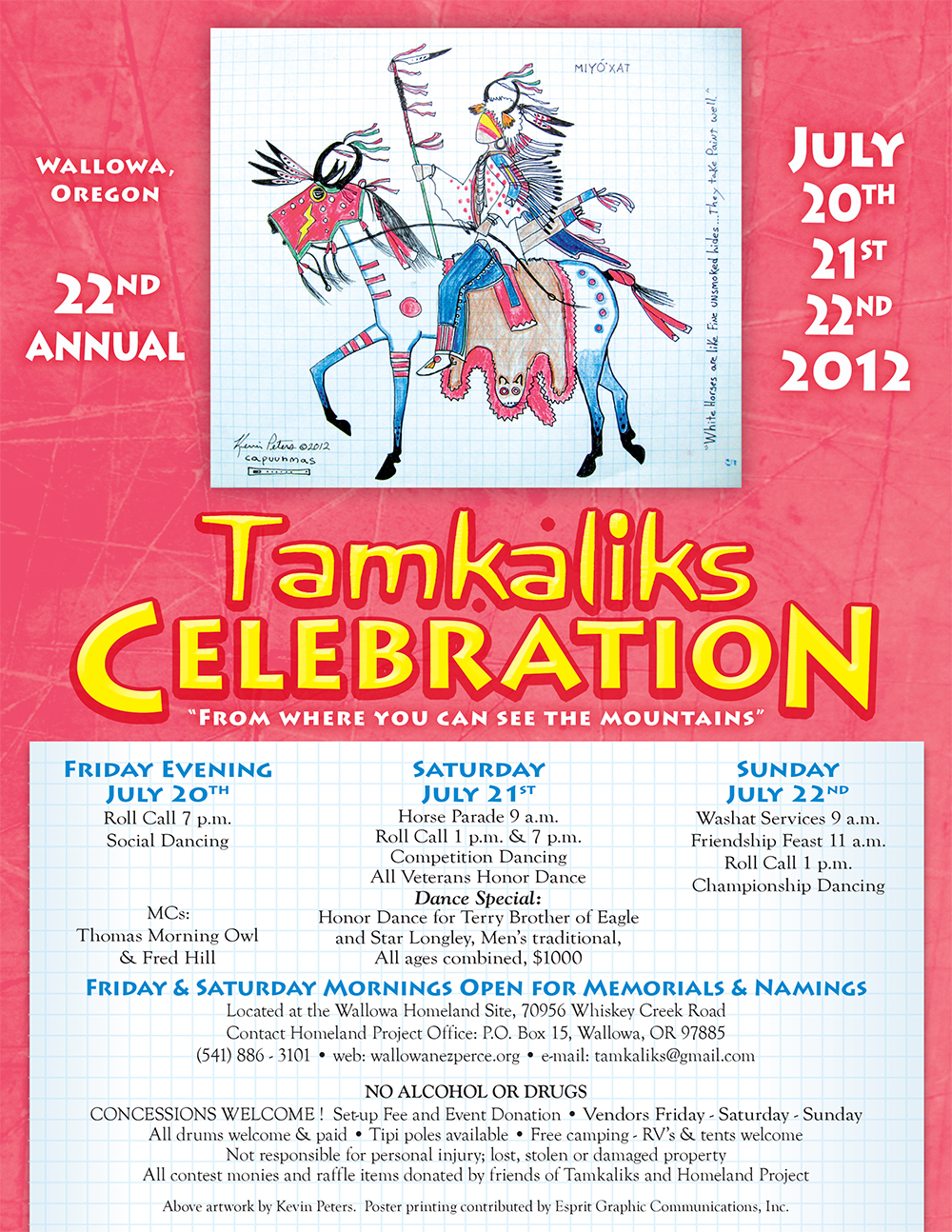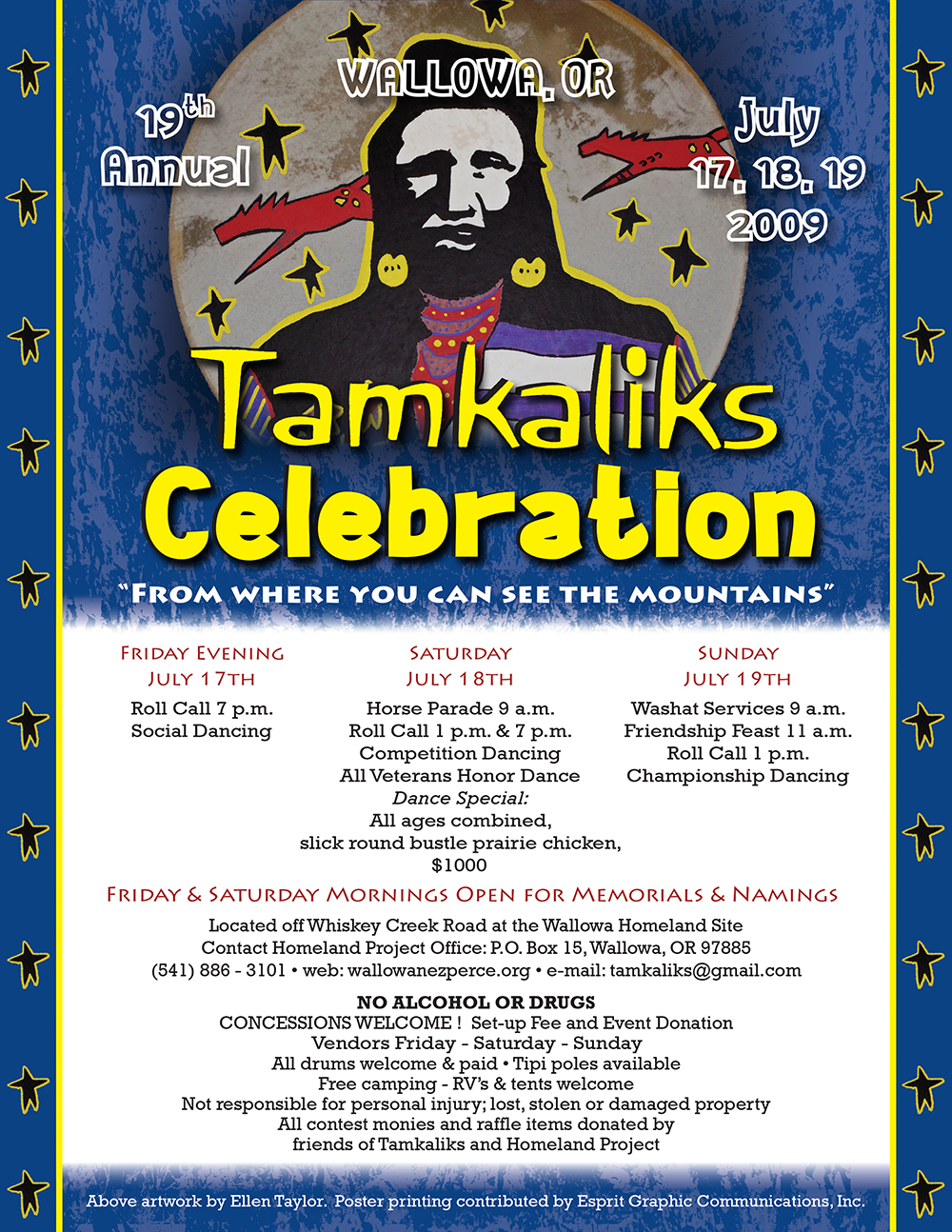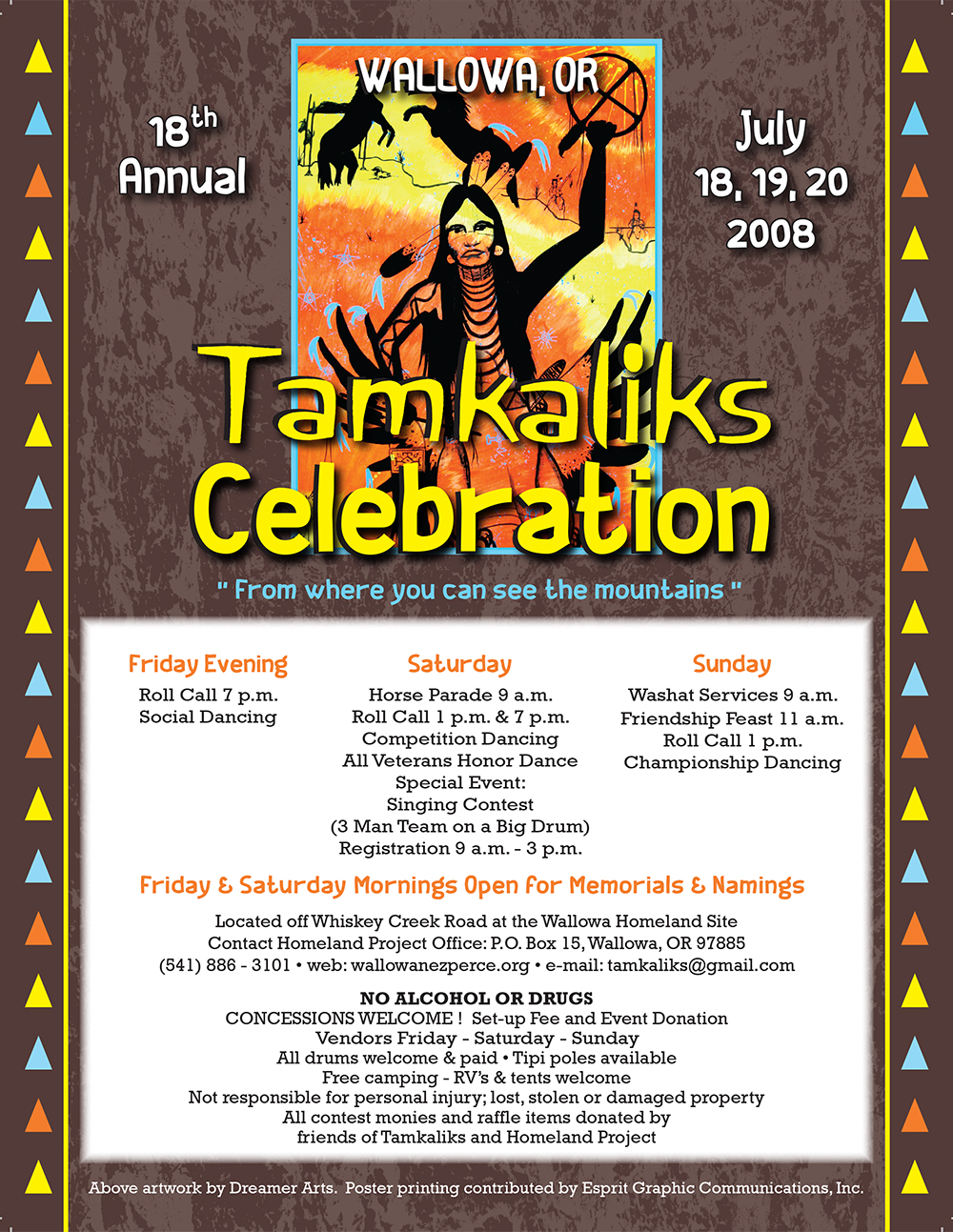Tamkaliks Celebration & Friendship Feast—
(almost) Always the 3rd Weekend in July
Each July, the Homeland becomes a place of reunion for descendants of the original inhabitants of waláwa, the Wallowa country. Year after year, participants enjoy three days of song and dance, culminating in a walasit service and Friendship feast. Descendants, locals, and visitors attend together. There are many ways to be involved, contribute, and enjoy. Camping and dancer registration is free. Winners and drums are paid in cash. Big ticket raffle items include a buffalo hide and a Pendleton blanket each year. Food and craft vendors are plentiful. All the comforts of town are just a quick walk across the river.
The 33rd Annual Tamkaliks Celebration will be held on the 18th, 19th and 20th of July 2025
The schedule will be posted on this page soon!
Support the Tamkaliks Celebration
Help make the Tamkaliks a celebration to remember by becoming a sponsor. Your sponsorships will go toward paying drum groups and prizes for dance contest winners. You’ll find more information about the different dance contests below. Donate $25 or more to become a Tamkaliks sponsor and your name or business name will be listed in the 2025 Tamkaliks Celebration program.
Each year, the Tamkaliks Committee awards two scholarships to a Native student and a local Wallowa County student pursuing higher education.
Scholarships:
Taz Conner Memorial Scholarship
Terry Crenshaw Memorial Scholarship
Jo Hallam Family Scholarship
Duane Heglie Family Scholarship
Now Accepting Vendor Applications for 2025 Tamkaliks Celebration!
Apply to be a vendor at Tamkaliks:
Download the vendor application below and submit by mail or email. P.O. Box 15 Wallowa OR 97885, info@wallowanezperce.org
Pay your vendor fee:
Mail a check made out to Tamkaliks Celebration to P.O. Box 15 Wallowa OR 97885
The online application is currently being updated and will be available for Tamkaliks 2026
Tamkaliks Merch coming soon!
We have t-shirts & tank-tops for sale at our Visitor Center in Wallowa. Don't miss out on adding the 33rd Celebration t-shirt to your Tamkaliks t-shirt collection!
T-shirts will also be for sale at the Tamkaliks Celebration Grounds.
This year’s featured artwork is by artist, Nizhonia Toledo.
The Tamkaliks Celebration is a celebration and recognition of the continuing Nez Perce presence in the Wallowa valley. A standing committee of the Nez Perce Wallowa Homeland oversees and organizes the Tamkaliks Celebration. The Tamkaliks Committee President is Fred Hill. He may be reached through the NPWH Office.
History
“In 1989, Taz Conner, a descendant of Old Chief Joseph, Tuekakas, was invited by the City of Wallowa to help them plan some kind of Native American festival in Wallowa. It was decided that a friendship potluck and powwow would be the most appropriate event. Since that time, a group of ten to fifteen local volunteers have met, planned, and worked nearly year-round to conduct the event. During the powwow and potluck, about forty to fifty local people and ten to twelve Native Americans help in putting it on. - Terry Crenshaw, Teacher at Wallowa High School”
In 1990, the powwow was in the high school gym and the potluck on the school grounds. There were about fifty participants and everybody felt it was a great success. By the third year it had to moved outside along the Wallowa river because it had grown too large for the gym. In 1998 the event was renamed Tamkaliks (from where you can see the mountains) and moved again to it’s permanent home on the Nez Perce Wallowa Homeland property at the edge of the city of Wallowa.
Dance Categories
Grand Entry
Each dance session begins with a Grand Entry, a procession of dancers. The Flag Bearers lead the procession carrying the Eagle Staff, American Flag, The Canadian Flag, and frequently, the MIA-POW Flag. Being a Flag Bearer is an honor usually given to a veteran, a respected traditional dancer, or a traditional elder. Everyone is asked to stand during the Grand Entry and men should remove their head coverings unless it has an eagle feather. After all the dancers are in the Arbor, a flag song is sung to honor the Eagle Staff and flags. Then a respected person, usually an elder, offers a prayer. This is followed by a victory song during which the Eagle Staff and flags are placed in their standards.
Dance Contests
While the dancers are competing with one another, they are also in contest with the drummers and singers. A drum group may sing a trick song with many surprise stops. The best dancers know the songs, and dance closely to the beat to hit every drum stop. Judges look for dancers to reflect their own personal style as well as their ability to carry on traditions that go with specific songs or dances. The dancers will be evaluated for footwork, rhythm, agility, and demeanor. Regalia should be appropriate and reflect care and maintenance. A dancer may be disqualified or disqualify him\herself if an article of regalia fall off. Dancers follow directions from the Whipman & Whipwoman.
Eagle Feather Pick Up – Eagles and eagle feathers are revered by many tribes of this continent because of the bird’s characteristics, abilities and closeness to the Creator. Eagle feathers are a symbol of honor and good medicine. When an eagle feather or fluff is on the ground, all other proceedings cease until a veteran ceremonially retrieves the feather. The feather symbolizes a fallen warrior.
Circle Dance – Everyone can join in this dance of friendship. The circle of dancers moves to the lift in the clockwise direction and three circle dance songs will be sung in succession. Variations of this nearly universal Native American social dance include the Oklahoma two-step, the rabbit dance, the owl dance, the serpentine, and the Indian square dance (in a circle) which mimics pioneer square dance moves to tribal songs.
Men & Boys Traditional – Dancers typically wear a breechcloth, moccasins, feather bustle, a porcupine and deer hair roach with a spreader in the middle made of bone, rawhide or leather in which roach feathers are mounted. Dancers compete to special songs. In the Crow Hop, dancers’ feet make slow deliberate moves to the beat, imitating a crow hopping. Actions in the Sneak Up illustrate events in war or hunting such as tracking enemies or game. In the Duck and Dive, the hard drumbeats represent cannon fire and dancers duck in unison to avoid being hit. The best dancers are light on their feet regardless of size and weight, match the drum with every move, bend close to the ground and use the whole body to dance.
Men’s Fast & Fancy – Extremely colorful beadwork, elaborate feather bustles, ribbons, scarves, horsehair tips, angora bands, sheep bells, a roach headdress and dance sticks all punctuate the most spectacular display of dance stunts and movements in this very fast paced contest that began in the 1950’s. After WWII, Korea, and the federal Indian Relocation policy that moved Indians to urban centers for jobs, many pan-Indian powwows sprang up across the U.S., and so did this dance. Drummers may orchestrate many quick stops in a song to test the dancers and to highlight the dancers’ athletic abilities.
Grass Dance – Wearing lots of fringe (representing tall blades of prairie grass), a porcupine and deer hair roach and no bustle, this dance was popularized by Northern Plains peoples where tall prairie grasses needed to be flattened for encampments or gatherings. Moves show how they would gracefully bend, fold, and weave greases to an even surface, and dancers’ ribbons and yarn sway as grasses would.
Women’s Fancy Shawl – Wearing a cloth fitted dress with ribbon and appliqué and complementing shawl with long fringe, leggings, cuffs, moccasins, hair ties, choker, and earrings, this dance imitates the rapid and fluid movements of butterflies. The light spinning and jumping moves requires athleticism & timing with the drum. Watch for complex footwork as well as poise, grace and agility.
Women & Girls Traditional – Plateau Women’s dresses may be made of buckskin, wool, velvet, or dresses are adorned with dentalia, cowry, or abalone shells, elk teeth, ribbon, seed and bugle beads as well as fringe on the sleeves and hem. Plateau dresses typically have shorter fringe and more flared skirts than plains dresses. Hand woven hats, headbands or beaded hair ornaments with feathers may be worn. In this category, two songs are typically sung in contests so that the females demonstrate both a slow and graceful straight style war dance and a circle dance. Historically, Plateau women did not war dance but would encircle the drum or dance area and keep time with the music standing in place gently bouncing or lightly swaying. In rare instances women who had committed deeds in combat such as taking the life of an enemy, rescuing others, or escaping from enemy captivity would join the men in the war dance. After WWII, as many women veterans returned from service in the armed forces it became more common to see women war dance. The dance exemplifies light-footedness, grace, modesty, and dignity with each song.
Women’s Jingle Dress – In 1920, after a medicine man’s granddaughter became ill, his spirit guides told him in a dream to make her a dress that would please the ear and have her dance in it to heal her. The dress is decorated with rolled up snuff can lids or baking powder lids hanging from ribbon. There are two styles of jingle dance – a slide step and straight.
2024
Women’s Traditional - Golden
Women’s Traditional - Adult
Women’s Traditional - Teen
Junior Girl's Traditional
Jingle Dance, All Ages
Fancy Shawl, All Ages
Men's Traditional - Golden
Men's Traditional - Adult
Men's Traditional - Teen
Junior Boy's Traditional
Grass Dance, All Ages
Fast and Fancy, All Ages
Short Fringe Special
Slick Style Special


